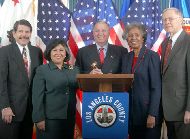3/20/2009
Los Angeles County Flat-Rate Traffic Camera Contract Flattens ProfitAdhering to the flat-rate contract law means Los Angeles County, California loses money with red light cameras.

The Los Angeles County, California Board of Supervisors on Tuesday approved a contract allowing Affiliated Computer Services (ACS) to continue operating red light cameras in East Los Angeles, El Segundo, Glendora, Rowland Heights and Whittier. The county also approved a contract with the California Highway Patrol (CHP) to oversee the program, as the state agency has jurisdiction over moving violations on county roads. Among the CHP's formal duties is determining the the locations where the county's eight red light cameras should be placed to best improve safety.
"The camera units shall be rotated to an unattended housing at the request and schedule of the CHP," the contract between ACS and the county states.
Although the CHP can bill the county up to $100,000 for this service, documents reveal that the CHP does little beyond rubber stamping the decisions of ACS. For example, the intersection selection function is entirely controlled by ACS and designed to generate the maximum amount of revenue.
"ACS recommends executing a monthly camera rotation schedule between the locations listed below," ACS Vice President M.J. Hannigan wrote in a 2006 letter to the county. "The net effect of this effort will yield cost-savings of $19,600 a month or annualized at $235,200 for the contract... We will implement the above changes to the program starting February 1, 2006 unless we hear from you stating otherwise."
For its services, ACS has received the same flat-rate monthly payment of $58,800 since March 2006 -- in accordance with state law. The new contract cuts this price by $2940 a month to reflect savings from newer technology. Even though tickets issued by ACS cost drivers $400 each, the program only generates a net profit for the state and ACS. About 2150 tickets, worth almost $850,000, are paid each year. The county only keeps $132.54 per ticket under state law, sending the rest to Sacramento. From the county's share of $284,961, ACS is paid $670,320 and the CHP $100,000. Given the current economic difficulties in the state, the county reserved the right to cancel the program on financial grounds.
"In the event that any budget reductions occur in any future fiscal year throughout the program, provisions remain in the contract for the county to consider termination at any time," Department of Public Works official William H. Higly reminded the board of supervisors in a memo.
Although the city's publicity documents claim, as evidence of safety improvement, that violations will go down five percent each year, the official budget documents predict that the 28 tickets per intersection per month figure established in 2007 would grow to 30 in 2008 and 32 in 2009. Officials did not report on the overall impact on intersection safety and rear-end collisions at the photo enforced intersections.
A copy of the FY09-10 budget documents is available in a 400k PDF file at the source link below.


